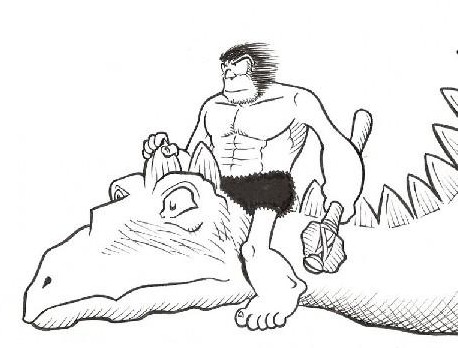
Click Here for Free Bodybuilding and Fitness Magazine Subscription
Paleo Bodybuilding
Get Lean Quick 14 Day Fat Loss Kit
I finished my two week "Get Lean Quick" program. My first week I lost 15 lbs, second week 10 lbs, a total 25 lb loss. I was 220 lbs and went to 195 lbs, I am 58 yrs 5' 10" tall. The program was very easy to follow, and I did not have to starve myself. Thanks for your help and guidance, you have always taken the time to answer all my emails. I will continue to keep the fat off. This program has taught me important info on nutrition and exercise.
Thank you!
Regards,
Mike G.
We are happy to announce the New Get Lean Quick 14 day kit is in and available for immediate shipment. We send by priority mail, so you can get started in just a few days!
For full information go to https://www.trulyhuge.com/get-lean-quick.html
You can also order Get Lean Quick by calling 800-635-8970 or 503-648-1898, 10 am to 6 pm PST
What Did Paleo Man Really Eat?

Did Paleo Humans REALLY Eat Like the So-Called “Paleo Diet”?
Of all the “fad” eating plans to come along in the last couple of decades, the paleo diet seems to have more staying power than just about any other. Maybe it’s the romanticism of eating like our ancestors, or maybe paleo just delivers the goods better than other diets. Whatever it is that makes it so popular, paleo won’t disappear anytime soon.
But some in the bodybuilding, fitness and nutrition industries question whether or not paleo lives up to its name. Did our cavemen predecessors REALLY eat like the modern paleo diet would indicate?
Let’s take a look at the principles behind paleo, the truth about ancient diets, and how well the two mesh.
Principles of the Paleo Diet
The paleolithic diet, or “paleo” diet, is based on the idea that humans have only practiced various forms of agriculture for about 10,000 years. That’s not very long at all when you consider that we’d been grunting along for 5-7 million years before that.
The paleo supporters claim that the 100 centuries we’ve been growing our own food is not long enough for our digestive systems to evolve to accommodate the grains that now make up a major portion of our modern diets. Rather, paleo advocates that we return to eating the natural foods that ARE appropriate for our largely unchanged bodies: meat, berries, nuts, greens, maybe some fruits, whole eggs, the occasional fish, maybe some tubers — but maybe not, depending on whom you ask.
The guiding principle of paleo is to eat whole, unrefined foods that you would have found in nature BEFORE we started farming.
At the risk of oversimplifying it, paleo is your basic hunter-and-gatherer fare.
How Did Paleo Humans REALLY Eat?
Technically speaking, the paleolithic period started about 2.5 million years ago and ended around 200,000 years ago. In the beginning of that span, we probably weren’t even quite human yet, at least not in the way we think of ourselves today. Our ancestors had some crude tools, but life was much different than what we can even imagine today.
And that’s part of the problem with pegging a prototypical “paleo” diet: we just don’t know for sure what ancient humans ate.
What’s more, it varied from region to region.
In desert areas, meat would likely have been scarce, so nuts and berries (or their equivalent) might have been staples. In very cold climates, on the other hand, not much in the way of fresh vegetation would have been available, so clubbing a snaggle-toothed penguin-osaurus may have been the best option for dinner most nights.
What we do know is that it’s unlikely our ancestors ate grains in any great quantities. It was only when we settled down a few thousand years ago that we could start to rely on crops for food. The paleo diet is authentic in that respect no matter where else it might miss on specific ancient food choices.
Is It Healthy?
Regardless of whether the paleo diet represents exactly what ancient humans ate, what’s really important is what the plan can do for you today. Is paleo healthier than the typical modern American diet?
The answer is almost certainly “yes” since paleo focuses on raw, unprocessed foods, which are at the core of many modern health problems, from diabetes to heart disease.
Speaking of heart disease, though, one potential problem with paleo is the boost in total cholesterol numbers that can accompany heavy meat and egg consumption. While many paleo supporters downplay this as a problem, it’s worthy of consideration if you have a family history of heart disease or other concerns.
Another slightly more obscure concern is that paleo often leads to a higher intake of omega-6 fatty acids than omega-3 fatty acids, and this is thought in some circles to increase overall inflammation in the body. More inflammation generally means a higher likelihood of diseases of all sorts.
On the whole, though, moving from a diet filled with refined sugars, processed meats, and heavy on grains to one focused on nuts, berries, free-range meat, and eliminating processed foods would be a step toward healthier living for most Americans.
For bodybuilders who don’t yet have their nutrition in order, paleo holds a lot of promise for helping to satisfy protein needs while avoiding the blood sugar swings that can come from eating too many refined foods.
If you’re considering making the switch to paleo, read all you can and get a complete checkup with your doctor. Tell him what you have planned and make sure that the diet won’t harm your health. If you get the OK, then paleo might help you build a better physique, even if it’s not quite caveman worthy.

